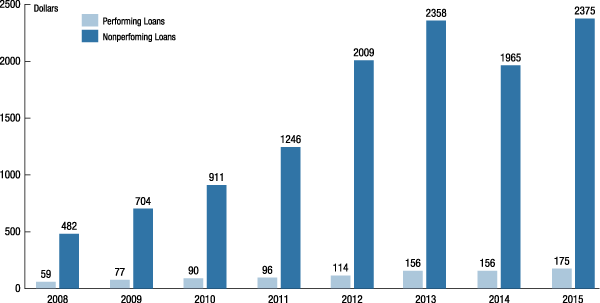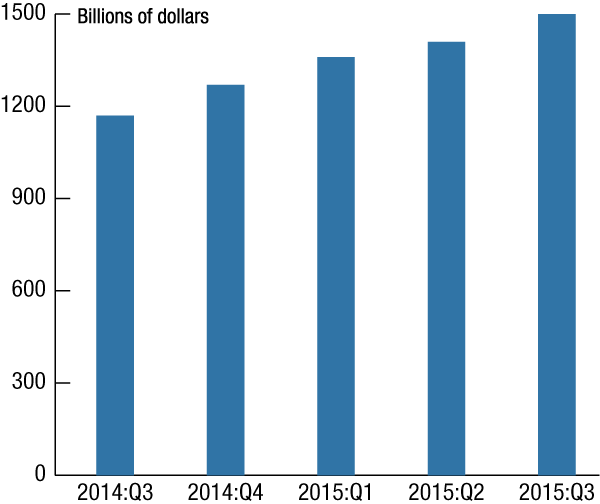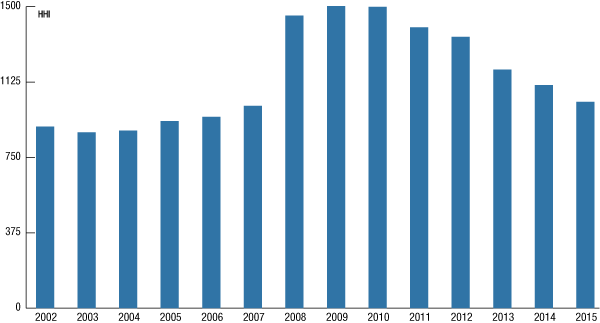Report to the Congress on the Effect of Capital Rules on Mortgage Servicing Assets
- Preface
- Executive Summary
- Background
- Risks to Firms Holding Mortgage Servicing Assets
- Role of Mortgage Servicing Assets in Bank Failures
- Regulatory Approaches for Mortgage Servicing Assets
- Evolution of the Mortgage Servicing Market since 1998
- Potential Impact of the Revised Capital Rule on the Mortgage Servicing Business
- Potential Impact of the Revised Capital Rule on Nonbanks
Potential Impact of the Revised Capital Rule on the Mortgage Servicing Business
Cost of Loan Servicing and Economies of Scale
One of the most significant factors affecting the ability of all firms to compete in the mortgage servicing business is the increase in the cost of servicing loans. For example, as shown in figure 18, data collected by the Mortgage Bankers Association indicate that the annual cost of servicing a performing loan more than doubled from $59 in 2008 to $175 in 2015, whereas the annual cost of servicing a nonperforming loan more than quadrupled from $482 to $2,375 in the same time period.96 In addition, the time it takes a servicer to resolve a nonperforming loan has increased substantially, adding to the total servicing cost.97

Source: Mortgage Bankers Association Servicing Operations Study and Forum.
Against this backdrop of rising costs overall, a firm may also achieve lower servicing costs if it is able to harness economies of scale. Some aspects of mortgage servicing become cheaper--as measured by the average cost to service a loan--when the firm services a larger number of loans. This relationship, known as "economies of scale," stems from the fact that some costs, such as investments in technology and staff expertise in regulatory compliance, are upfront investments with benefits that are spread out across the firm's mortgage servicing book.
To illustrate this point, table 3 shows the average cost to service a loan broken out by the size of the firm's servicing book. The estimates are based on data submitted by 160 independent mortgage companies and subsidiaries of banks through their Quarterly Mortgage Bankers Financial Reporting Forms.98 The average cost to service a loan follows a U-shape. The average annual cost as measured by total direct expenses is roughly around $250 a year for the smallest and the largest firms; the average annual costs are lower for the firms servicing between 2,500 and 10,000 loans and between 10,000 and 50,000 loans, at $170 and $219, respectively.
| Expense | Servicing volume, number of loans | |||
|---|---|---|---|---|
| Less than 2,500 | 2,500- 10,000 |
10,000- 50,000 | Greater than 50,000 | |
| Total direct expenses | $254 | $170 | $219 | $242 |
| Personnel | $96 | $76 | $92 | $115 |
| Occupancy and equipment | $7 | $4 | $9 | $8 |
| Technology-related | $2 | $4 | $8 | $10 |
| Subservicing fees paid | $138 | $70 | $70 | $52 |
| Other miscellaneous expenses | $12 | $17 | $39 | $58 |
| Average number of loans serviced | 1,231 | 5,166 | 22,940 | 368,327 |
| Seriously delinquent rate (% based on $) | 0.85 | 1.30 | 2.45 | 7.67 |
| Number of companies reporting | 36 | 45 | 47 | 32 |
Note: Expenses may not sum to total because of rounding.
Source: Mortgage Bankers Association, Quarterly Mortgage Bankers Performance Report, 2015.
The differences in average cost reflect both economies of scale and the composition of the firms' servicing book. As shown in the last row of the table, the serious delinquency rate for the firms that service the largest amount of loans (more than 50,000) is 7.7 percent, approximately eight times the delinquency rate of the firms with the smallest amount of loans (less than 2,500). The high average servicing cost for the firms with the largest amount of loans likely reflects primarily their outsized share of delinquent loans.
That said, the fact that firms that service between 2,500 and 10,000 loans a year have lower average servicing costs than firms that service less than 2,500 loans is consistent with the idea that economies of scale exist in mortgage servicing. Further, the costs are lower in these data for the firms that service between 2,500 and 10,000 loans a year despite the fact that these firms service mortgages with slightly higher delinquency rates than firms that service less than 2,500 loans.
In recent years, moreover, the growth in the subservicing industry has made it easier for small firms to harness economies of scale by contracting out certain servicing functions. Small firms can leverage subservicers' technology infrastructure, for example, or their specialized knowledge of the regulations applicable to nonperforming loans.99 As shown in figure 19, subservicing has grown significantly since at least the middle of 2014, with an estimated $1.5 trillion in mortgage loans serviced by subservicers by the fourth quarter of 2015.

As represented, at least, by the share of their servicing costs spent on subservicing fees, small firms appear more likely than larger firms to make use of subservicers. Table 3 indicates that subservicing fees represent about half of the servicing costs ($138 out of $254) for firms that service less than 2,500 loans, compared with around 20 percent of the costs ($52 out of $242) for firms that service more than 50,000 loans.
On the whole, the data suggest that smaller firms face higher costs to service a loan than larger firms, holding constant the characteristics of the underlying loans. To some extent, the cost disadvantage to smaller firms is offset by the rise in subservicing. Nonetheless, small banks that want to achieve an efficient cost structure through having a higher concentration of MSAs may face a tradeoff with the higher risks inherent in higher MSA concentrations and the costs of compliance with the revised capital rule, particularly if the bank's MSAs to CET1 capital ratio increases beyond 10 percent.100
Serve Consumers
Banking institutions take into account several factors when deciding whether to engage in the business of servicing loans held by other firms. Such factors include the cost, complexity, and risks involved with servicing mortgage loans; valuing the MSAs; and regulatory compliance, including regulatory capital requirements and servicing regulations. As noted, the growth of subservicers may make it easier for smaller firms to enter the mortgage servicing market.
For most banking institutions that hold MSAs, the MSA treatment under the revised capital rule generally has a minor impact. Based on the earlier analysis of banks' MSAs to CET1 ratios, the deduction threshold does not affect the vast majority of banking institutions. As discussed, the increase in the risk weight for a banking institution with an MSAs to CET1 capital ratio below 10 percent could have a relatively small effect, given that under the previous regulatory capital framework the amount of MSAs includable in regulatory capital was limited to the lesser of 90 percent of the MSAs' fair value or 100 percent of the MSAs' carrying amount, potentially resulting in an effective risk weight of up to 215 percent. For other banking institutions the increase in the risk weight for MSAs could be more significant starting in 2018. That said, Call Report data as of June 30, 2015, adjusted to estimate the impact of the fully phased-in regulatory capital requirements, show that approximately 99 percent of all insured depository institutions are above the 4.5 percent CET1 capital minimum ratio and approximately 99 percent of all insured depository institutions are above a 7 percent CET1 capital ratio, which is equivalent to the 4.5 percent minimum CET1 capital ratio plus the fully phased-in 2.5 percent capital conservation buffer. Thus, the vast majority of banking institutions would not face restrictions on capital distributions and certain discretionary bonus payments under the revised capital rule when accounting for the fully phased-in capital requirements, including the revised MSA treatment. Finally, the revised capital rule's treatment of MSAs generally does not impact banking institutions that service mortgages that these firms originate and hold for investment in their portfolio.
The revised capital rule is likely to have the greatest continuing effect on banking institutions that want to specialize as aggregators of MSAs. Such banking institutions face incentives under the revised capital rule to keep their servicing books under a certain size because MSA values above certain thresholds must be deducted from CET1 capital. Inasmuch as there are economies of scale in mortgage servicing, it may be difficult for certain smaller firms that want to specialize as aggregators of MSAs both to achieve an efficient cost structure and to maintain an amount of MSAs that is below the deduction threshold.
A pullback of aggregator banking institutions from the MSA market could have effects on other firms and on MSA pricing and liquidity. However, the findings suggest that most banking institutions have sufficient capital to comply effectively with the MSA treatment under the revised capital rule. The increased capital strength and resiliency of banking institutions as a result of the revised capital rule will also make it easier for institutions to navigate periods of stress.
The extent to which a pullback by aggregators affects the mortgage servicing market depends on the extent to which other firms are interested in servicing mortgage loans. As noted earlier, the vast majority of banking institutions have MSAs to CET1 capital ratios well below 10 percent. These banking institutions may be willing to increase their purchases of MSAs, and indeed, small banks appear to be increasing their MSA market share. Nonbanks may also be interested in purchasing servicing rights.
To date, the mortgage servicing market appears to have stayed competitive. On this point, figure 20 displays the evolution of a standard measure of market concentration, the Herfindahl-Hirschman Index (HHI).101 High values of this index suggest that the industry is heavily dominated by a small number of firms, whereas low values signal that the market shares are relatively evenly distributed among a large number of competitors. The DOJ defines a market as moderately concentrated if its HHI is between 1,500 and 2,500 points, and as highly concentrated if its HHI is in excess of 2,500 points.102

Source: Staff calculations based on Inside Mortgage Finance data on top 30 servicers in each year.
Before the financial crisis, the HHI hovered around 1,000, well below the levels of concern. The contraction in servicing during the financial crisis pushed it up to 1,500. In recent years, though, as many large banks have reduced their MSA holdings, the concentration has returned to close to pre-crisis levels, and well below the levels that indicate concern about market concentration.
References
96. Data are from the Mortgage Bankers Association Servicing Operations Study and Forum. Return to text
97. Goodman, Servicing Costs, 2-3. Return to text
98. For more information on the Mortgage Bankers Financial Reporting Form (MBFRF), see www.fanniemae.com/content/guide_form/form-1002-mortgage-bankers-financial-reporting-form ![]() . Companies may choose to release their MBFRF data to the Mortgage Bankers Association for use in aggregate industry statistics. Return to text
. Companies may choose to release their MBFRF data to the Mortgage Bankers Association for use in aggregate industry statistics. Return to text
99. Note that under a subservicing arrangement, the MSAs remain on the servicer's balance sheet. Return to text
100. NCUA capital requirements do not deduct any MSAs from regulatory capital. Return to text
101. The HHI is defined as the sum of squares of individual firms' market shares (expressed in percentage points) at a given point in time. These estimates will overstate the HHI because they are based only on the 30 largest firms. If they were based on all mortgage servicers, the HHI would be lower. Our estimates are similar to those calculated by the GAO. Nonbank Mortgage Servicers, 65-67. Return to text
102. Information on the HHI can be located at www.justice.gov/atr/herfindahl-hirschman-index. Return to text
